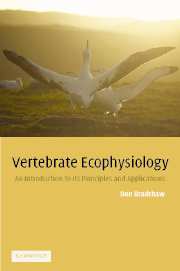Book contents
- Frontmatter
- Contents
- Introduction
- 1 Homeostasis: a fundamental organising paradigm in ecophysiology
- 2 Stress: the concept and the reality
- 3 Basic methods used in ecophysiological studies
- 4 Turnover methodology: theory and practice
- 5 Case studies of stress: incidence and intensity
- 6 Survival in deserts
- 7 Torpor and hibernation in cold climates
- 8 Marine birds and mammals
- 9 Conclusion
- Appendix 1 Population estimation methods
- Appendix 2 Estimation of food intake in Tiliqua rugosa
- Appendix 3 Simultaneous measurement of sodium and potassium concentration in plasma or urine using the IL 143 digital flame photometer
- Appendix 4 Determination of plasma urea nitrogen
- Appendix 5 Radioimmunoassay of testosterone in plasma
- Appendix 6 Preparation of ‘stripped plasma’
- Appendix 7 Radioimmunoassay of testosterone in faeces
- Appendix 8 The comparative method
- Appendix 9 Basic turnover equations
- References
- Index
3 - Basic methods used in ecophysiological studies
Published online by Cambridge University Press: 05 June 2012
- Frontmatter
- Contents
- Introduction
- 1 Homeostasis: a fundamental organising paradigm in ecophysiology
- 2 Stress: the concept and the reality
- 3 Basic methods used in ecophysiological studies
- 4 Turnover methodology: theory and practice
- 5 Case studies of stress: incidence and intensity
- 6 Survival in deserts
- 7 Torpor and hibernation in cold climates
- 8 Marine birds and mammals
- 9 Conclusion
- Appendix 1 Population estimation methods
- Appendix 2 Estimation of food intake in Tiliqua rugosa
- Appendix 3 Simultaneous measurement of sodium and potassium concentration in plasma or urine using the IL 143 digital flame photometer
- Appendix 4 Determination of plasma urea nitrogen
- Appendix 5 Radioimmunoassay of testosterone in plasma
- Appendix 6 Preparation of ‘stripped plasma’
- Appendix 7 Radioimmunoassay of testosterone in faeces
- Appendix 8 The comparative method
- Appendix 9 Basic turnover equations
- References
- Index
Summary
Animal welfare and the ethics of experimentation
Recent years have seen a welcome change in the attitude of some scientists towards animals, especially towards those species that are routinely used for experimental purposes. In the not too distant past, experiments were carried out where animals were subjected to considerable distress and it is largely due to public attitudes that such experimentation is now banned and all procedures are carefully scrutinised by Animal Ethics Committees before being approved. Copies of the Australian National Health and Medical Research Council (NH&MRC) Code of Practice may be had by visiting the following website: http://www.health.gov.au/nhmrc/research/awc/code.htm
Experiments in which animals are subjected to stress are without value scientifically as, often, the animal's appropriate responses are masked or overwhelmed by the stress to which they are exposed. One can never be sure that animals housed in laboratory situations are behaving ‘normally’, although the laboratory is the only place where hypotheses can be properly tested. It is thus extremely important that every effort is made to ensure that animals held in laboratories are given an environment sufficiently diverse for them to display their normal behaviour and physiology. A classical case in point is that of reptiles, which were thought for many years to be ‘cold-blooded’ because, in laboratory situations, their body temperature closely parallels that of the surrounding environment.
- Type
- Chapter
- Information
- Vertebrate EcophysiologyAn Introduction to its Principles and Applications, pp. 15 - 57Publisher: Cambridge University PressPrint publication year: 2003



